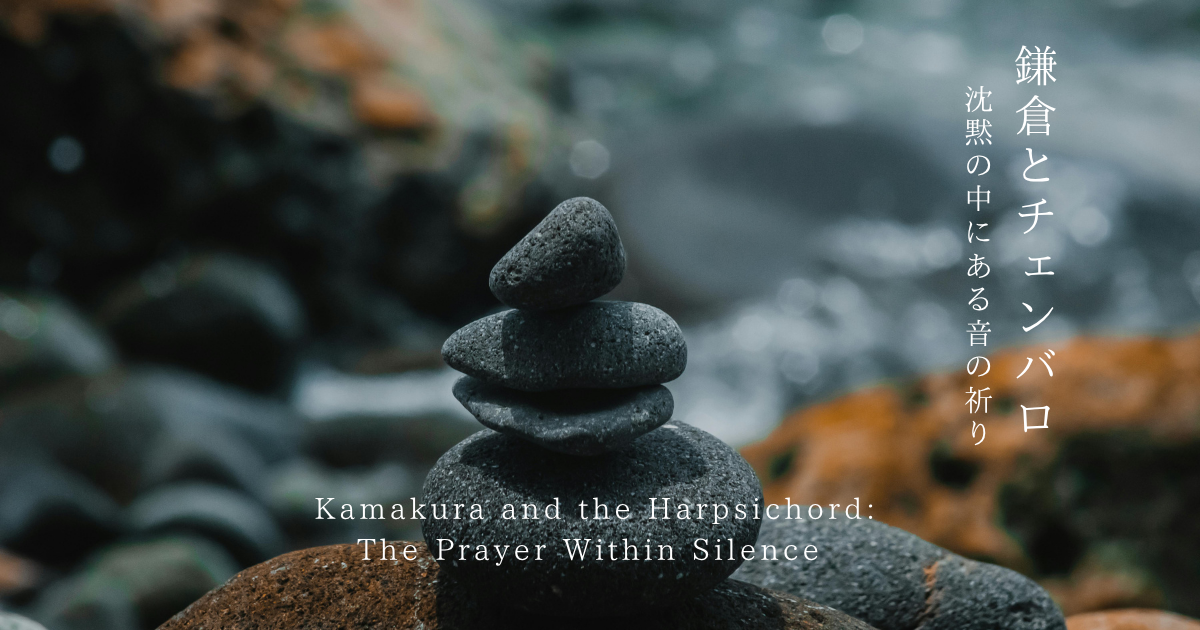空気の音聴こえますか?|Can You Hear the Sound of the Air? チェンバロと鎌倉-Harpsichord&Kamakura-
忙しさの中で、静けさを感じる時間がなくなってはいないでしょうか?
私たちは日々、情報と音に囲まれながら生きています。
けれど、本当に心が癒される瞬間は、何も「音」がないとき
――むしろ“静寂そのもの”の中にあるのかもしれません。
鎌倉をゆっくり散歩して、境内の空気の音に耳を澄ませたとき、私はそのことを思い出しました。
Are you losing time to feel quietness in your busy life?
We live surrounded by information and sound every day.
But the moment when our heart is truly healed is not when there is “no sound.”
—It might be inside “the silence itself.” I remembered that when I took a slow walk in Kamakura and listened to the sound of the air in the temple grounds.
魂を浄化する祈り|A Prayer that Cleanses the Soul チェンバロと鎌倉-Harpsichord&Kamakura-
鎌倉の静けさとチェンバロの響きは、“魂を浄化する祈り”のような調和を生み出す。
なぜ、この二つがこんなにも心に響くのでしょうか?
それはきっと、チェンバロのどこか懐かしい繊細な音色が、古都の持つホッとできる静けさとぴったり重なって、私たちが本当に求めている「心地よさ」を届けてくれるからかもしれません。
忙しい毎日をリセットしてくれる、贅沢な心の休息を、無意識に人は求めるのでしょう。
The quietness of Kamakura and the sound of the harpsichord create a harmony like a “prayer that cleanses the soul.”
Why do these two things touch our hearts so deeply?
Maybe it is because the harpsichord’s somewhat nostalgic and delicate sound perfectly matches the cozy quietness of the old capital.
It delivers the “comfort” that we truly look for.
People might unconsciously seek a luxurious rest for the mind, which resets their busy daily life.
「侘び寂び」の美意識|The Aesthetic of “Wabi-Sabi” チェンバロと鎌倉-Harpsichord&Kamakura-
鎌倉には「侘び寂び」の美意識があります。
それは、完璧を求めるのではなく、「不完全の中にある美」を見出す心。
古楽――特にチェンバロの音にも、同じ精神が宿っています。
装飾的でありながら、どこか儚く、すぐに消えてしまう響き。
その「消える音」にこそ、祈りのような清らかさがあるのです。
Kamakura has the Japanese aesthetic of “Wabi-Sabi.”
It is a mind that finds “beauty in imperfection,” instead of seeking perfection.
Old music—especially the sound of the harpsichord—has the same spirit.
The sound is decorative, yet somewhat fleeting, and disappears quickly.
It is in that “disappearing sound” where the cleanliness like a prayer exists.
沈黙を聴く|Listening to the Silence チェンバロと鎌倉-Harpsichord&Kamakura-
ある日の鎌倉の古い寺院の風の音を思い出しながら、私はチェンバロを奏でました。
鳥の声、木々のざわめき、遠くの波――すべてが一つの音楽のように感じられた瞬間、
私の中の“思考のざわめき”がすっと静まっていきました。
その時わかったのは、「音を奏でること」は「沈黙を聴くこと」と同じだということ。
侘び寂びも古楽も、どちらも“無”の中にある豊かさを讃えています。
I played the harpsichord while remembering the sound of the wind at an old temple in Kamakura one day.
Birds’ voices, the rustling of trees, the distant waves—at the moment when everything felt like one piece of music, the “noise of thoughts” inside me quietly disappeared.
What I understood then was that “playing sound” is the same as “listening to silence.”
Both Wabi-Sabi and old music praise the richness found in “nothingness.”
チェンバロと鎌倉-Harpsichord&Kamakura-
鎌倉の静けさは、魂が最も響く“舞台”です。
チェンバロの音が静寂に溶けていくように、私たちもまた、
日常の喧騒を離れて“何もない”時間の中でこそ、
本当の豊かさと祈りを思い出すのです。
The quietness of Kamakura is the “stage” where the soul resonates the most.
Just as the sound of the harpsichord melts into the silence, we also remember true richness and prayer only in the time of “nothingness,” away from the noise of daily life.



コメント